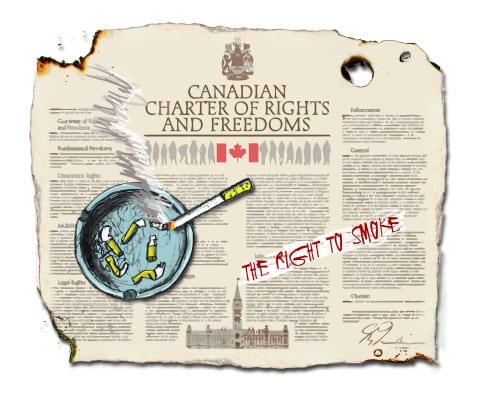“Smoking kills” — this sentence or some variation of it appears on every pack of cigarettes on the market. Enforcing a smoking ban due to the negative health effects of smoking would therefore not be useful, as every smoker already understands the health risks.
The University of Saskatchewan is not completely lacking in smoking restrictions. As it stands, it’s technically against the rules to smoke within 10 metres of any building on campus. The problem is that not only is this rule unenforced, but the way in which campus is set-up is not conducive to upholding it.
All around campus there are receptacles set up for the disposal of cigarette butts, but after a quick stroll around campus, I found that the majority of these are within a 10 metre radius of buildings and those that weren’t were in high traffic pathways. In some cases, these receptacles were no further than a couple feet from the doorways to these buildings.
Generally, these receptacles are taken as a sign that it is okay to smoke in that area, as they allow for the easy disposal of butts afterwards. So it is fairly obvious t hat this rule is not taken seriously and is more for show than anything else.
hat this rule is not taken seriously and is more for show than anything else.
For any ban or restriction to truly work, there must be consequences for breaking the rules. Furthermore, there must be an authority to enforce these consequences. My question is, “who is going topolice a campus-wide ban or even a restriction on smoking?”
Even if there was a force that would do so, they would have to be paid, unless anyone out there is willing to volunteer to go around telling people where they can and cannot smoke.
Restricting smoking to a certain area is not as simple as it sounds. If the area is not convenient, then many will choose to smoke where they please and the problem of secondhand smoke will remain.
So how do we remove the health risk of secondhand smoke? The only true solution that I can see is to remove the source, but this isn’t an easy task either. The decision to quit smoking has to come from the individual and not very many people are receptive to being forced to quit.
However, there are several options for those who do choose to quit, ranging from the typical Nicorette products to vaping, which has gained popularity as of late.
As someone who has quit smoking with the help of an electronic smoking device, I can attest to their effectiveness. You have the option to lower your nicotine intake at your own pace and it definitely tastes and smells a whole lot better. If you smoke a cigarette after vaping, it makes you realize just how bad a cigarette really tastes.
While vapour does contain some of the bad chemicals found in cigarettes, they are few in number and lower in content. So perhaps, instead of placing blame on smokers, we should instead keep an open mind and maybe try and promote the things that could lead them to being smoke free, like vaping, which in turn would lead to a much healthier society as a whole.
In the end, I can only see a further ban or restriction on smoking failing. Even if something were to come into effect, the measures that would be required to uphold it would have to be borderline extreme — not to mention costly — and at the expense of the U of S.
So instead of finding ways to tell people that they can’t smoke, we should try to find better ways to show them how to stop, because every smoker knows why they should.
—
Jack Thompson
Graphic: Jeremy Britz/Graphics Editor